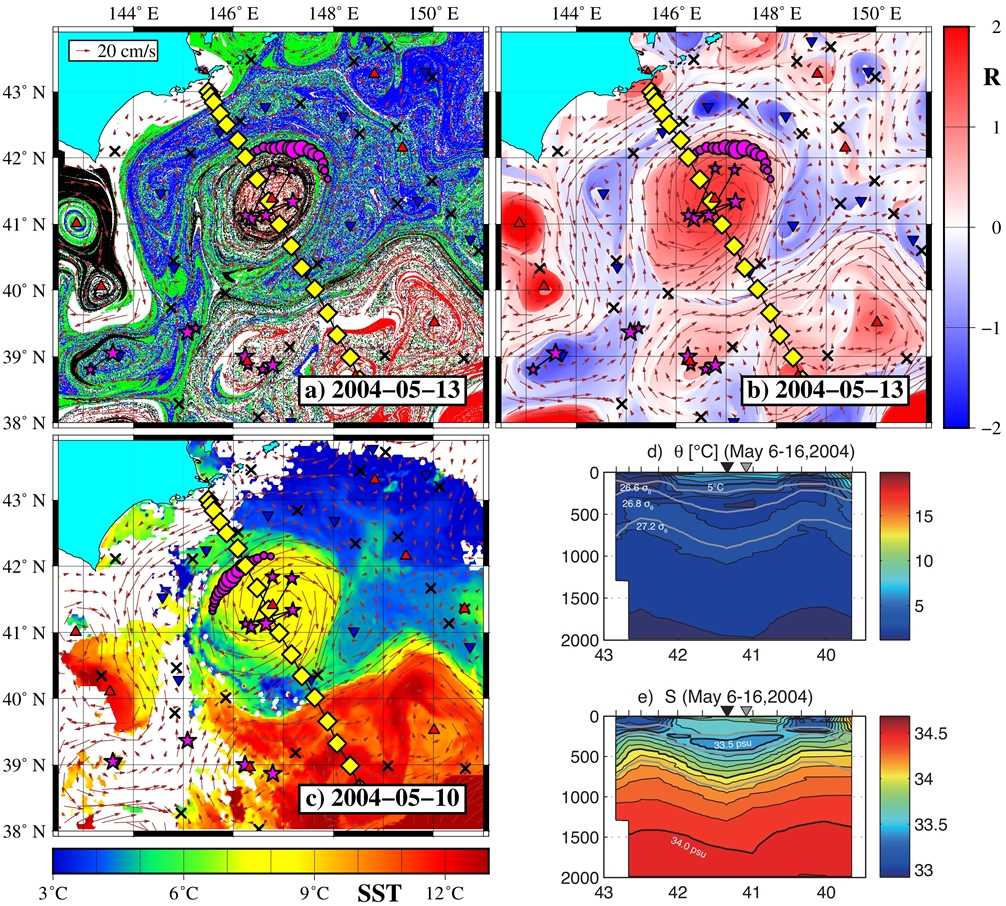There are no translations available.
The results of the Laboratory of Nonlinear Dynamical Systems (2017)
The Laboratory of Nonlinear Dynamic Systems (head. Lab - Prants S.V.) was one of the main organizers of the international conference
"Vortices and Coherent Structures: From Ocean to Microfluids" http://vcs.poi.dvo.ru/ , which successfully passed Vladivostok in the Pacific Oceanological Institute. V.I. Illicheva of the Far East Branch of the Russian Academy of Sciences from 28 to 31 August 2017
International Scientific Organizing Committee of the Conference: http://vcs.poi.dvo.ru/index.php/international-scientific-committee-of-the-conference
Conference program: http://vcs.poi.dvo.ru/index.php/conf-prog-2
According to voting at the Institute Scientific Council, the following result was recognized as the most important one in the Institute in 2017
Lagrangian oceanography
The book summarizes our 15 years work on developing a new Lagrangian approach to study transport and mixing in the ocean. It starts with chapters where we describe dynamical systems theory methods for description of chaotic mixing and transport in idealistic vortex and jet flows. Then the developed methods, based on computing different Lagrangian indicators in altimetric and numerically-derived velocity fields, are applied to different phenomena in the real ocean including mesoscale eddies, meandering jet currents, fronts, etc. It is shown how to identify in the AVISO velocity field daily locations of Lagrangian fronts defined as boundaries between waters with strongly different Lagrangian properties. It is statistically shown that these fronts may serve as proxy indicators of increased bioproductivity and potential fishing grounds. The developed methodology is also applied to simulate, identify and track the mesoscale eddies which have been sampled in the cruises after the Fukushima accident on March 11, 2011 and to estimate their risk to be contaminated by Fukushima-derived radionuclides. The simulated results are validated with in situ shipboard measurements, SST images, tracks of drifters and Argo floats.
According to voting at the Institute Scientific Council, the following result was recognized as the most important one in the Institute in 2017
Lagrangian oceanography
The book summarizes our 15 years work on developing a new Lagrangian approach to study transport and mixing in the ocean. It starts with chapters where we describe dynamical systems theory methods for description of chaotic mixing and transport in idealistic vortex and jet flows. Then the developed methods, based on computing different Lagrangian indicators in altimetric and numerically-derived velocity fields, are applied to different phenomena in the real ocean including mesoscale eddies, meandering jet currents, fronts, etc. It is shown how to identify in the AVISO velocity field daily locations of Lagrangian fronts defined as boundaries between waters with strongly different Lagrangian properties. It is statistically shown that these fronts may serve as proxy indicators of increased bioproductivity and potential fishing grounds. The developed methodology is also applied to simulate, identify and track the mesoscale eddies which have been sampled in the cruises after the Fukushima accident on March 11, 2011 and to estimate their risk to be contaminated by Fukushima-derived radionuclides. The simulated results are validated with in situ shipboard measurements, SST images, tracks of drifters and Argo floats.

Figure illustrates application of the Lagrangian approach to study a Hokkaido eddy sampled by profiling floats and in a few cruises in 2003 and 2004. a) The simulated Lagrangian map of the Hokkaido eddy shows the origin of its water masses. The eddy’s core is composed mainly of the subtropical “red” Kuroshio water. The eddy’s periphery is composed mainly of the “black” modified subtropical water originated from the Japan Sea, the “blue” subarctic water from the Oyashio Current and the “green” water from the Okhotsk Sea. b) The simulated map of anticyclonic (red) and cyclonic (blue) rotations of particles in the area on May 13, 2004 calculated for two weeks in the past. The transect along the Japan Meteorological Agency (JMA) line is imposed. c) SST on May 10, 2004. The AVISO velocity field is imposed by the arrows. d) Potential temperature and e) salinity profiles along the JMA line (Courtesy of S. Itoh).
S.V. Prants, M.Yu. Uleysky, M.V. Budyansky. Lagrangian oceanography: large-scale transport and mixing in the ocean. Berlin, New York. Springer Verlag. 2017. 271 p. ISSN 1610-1677.

